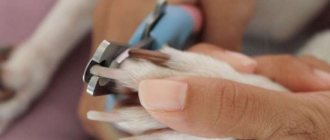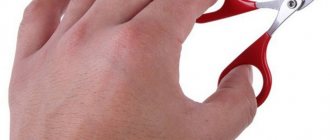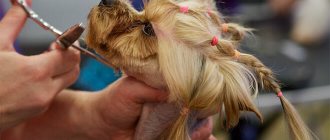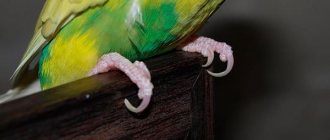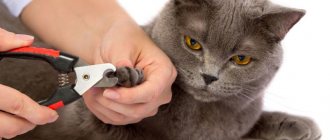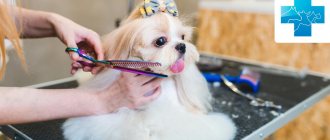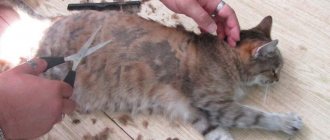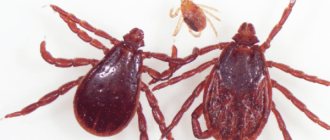Once you have a cat in your home, it brings with it the attendant dilemmas regarding nail care. The most significant problem for cat owners is torn wallpaper, sofas, beds, all kinds of carpets and cabinets, and endless scratches when trying to play with their pet.
This article details how to accurately trim an animal's nails at home without causing harm to yourself or your furry friend. At what age can you trim a kitten’s nails and how to choose the right clipping tool.
Why trim your cat's claws?
The joy of acquiring a furry neighbor is often replaced by concerns about the animal’s behavior. If a cat has not been accustomed to a scratching post since childhood and is inclined to swing its paw at the owner’s hand, there is a risk of getting an unpleasant surprise in the form of frequent scratches. Trimming cat claws is necessary and can be done at home:
- If your pet has an increased interest in furniture, this can completely ruin a sofa, armchair, set, or even renovations.
- If the pet has an aggressive character and has repeatedly scratched and injured its owners, family members and guests.
- If your pet is participating in shows: show breeds (British, Russian Blue, Maine Coon) may be disqualified for having untrimmed nails.
- There are pathologies in which animals have deformed phalanges and claws that grow into the paw pads. In this case, trimming the claws is a necessary procedure.
IMPORTANT: claws are an important tool of feline nature. Animals use their claws to hunt, climb to surfaces, and defend themselves. Completely declawing a pet is inhumane and unsafe for the animal's future life.
Nail trimming is a safe and necessary procedure for indoor cats.
Why do you need to cut your hair?
Nature has taken care of every living creature, and a cat’s claws were not given for beauty. In natural habitats, claws help a cat hunt for prey and escape from stronger opponents. With the help of its claws, the animal easily climbs a tree, escaping the dog and other enemies. But why do they need a domestic cat, who sees the whole world only from the apartment window?
Many owners believe that claws only bother a cat. And you can’t count how many troubles they cause for owners of furry pets:
- cling to carpets, curtains, upholstered furniture;
- During games, they can accidentally or deliberately scratch or injure a person.
Untrained cats often mistake a sofa, armchairs or carpet for a scratching post. And even if you place scratching posts in every room, the pet will leave marks of sharp claws on the furniture. There is only one way out - trim the claws so that they are not so sharp.
For animals participating in exhibitions, trimming their nails is a mandatory procedure. It is also recommended to do this:
- before mating;
- a visit to the veterinarian.
Small kittens, although they still have softer claws than adult cats, are also recommended to trim them so as not to injure the mother cat during feeding, and at the same time accustom them to manipulation. The sooner this is started, the less resistance the owner will encounter from the pet later during cosmetic procedures.
Important!
In no case should the claws of cats that have the opportunity to walk outside be trimmed: this can deprive them of the ability to defend themselves, which can lead to serious injuries and even death of the pet.
Preparing for your first haircut
Trimming nails should become a familiar procedure for your pet from an early age. You should periodically pick up the kitten in your arms and, pressing slightly on the pads of its paws, allow it to release its claws, while simultaneously massaging its paws. Over time, when the kitten begins to calmly respond to manipulation, it will be useful to reward it with treats, thereby reinforcing the positive habit.
IMPORTANT: a kitten should have its claws trimmed when it is 2 months old.
Ideally, the pet should be indifferent to the procedure.
The procedure can only be carried out when the animal is in a completely calm state. It is strictly forbidden to use physical force and raise your voice at your pet, but it is still necessary to show persistence: there is a chance that the pet will begin to worry and break out.
Talk affectionately, pet and treat your pet, and enlist the help of someone who can hold the animal. Do not insist on the procedure if the cat screams loudly and breaks out, this is fraught with psychological trauma and severe stress. Be patient if you want to make bone trimming a habit in your pet's life.
Make friends with your paw
Gently grab the paw and massage for 3-4 seconds. If the cat pulls it down, do not squeeze it, trying to hold it, but move your hand with it. When your pet calms down, lightly press the pad of your finger so that the claw appears. Then release the paw and reward the animal with a pre-prepared treat, divided into small portions.
Do this daily with different fingers until the clawed creature gets used to it.
Haircutting tools
First of all, to successfully perform a cat manicure, you need to acquire a tool. In specialized pet stores and veterinary pharmacies you can find all the equipment necessary for the procedure:
- Nail clipper-scissors. In appearance it resembles ordinary nail scissors, but with notches on the blade. It is in these grooves that it is convenient to insert a cat's claw so that it does not slip. The device allows you to quickly and evenly shorten claws.
- Trimmer in the form of a guillotine. The tool resembles pliers with a ring instead of blades. The trimmer is easy to use and very popular among experienced owners. Beginning cat breeders may have difficulty determining the length of the claw to cut.
- Nail clipper. The device is safe to use, as it has a locking system that prevents the blades from closing.
- Veterinary clinics and animal care salons use electric nail clippers, which are classified as professional tools.
Nail trimming tools
In a wide selection of cutting devices, the owner is often confused about how to trim a cat’s claws. If you have little experience in this procedure, then you should choose a nail clipper or scissors. The choice of tool also depends on the condition of your pet’s claws. If they are thin and transparent, then scissors or pliers will do the job, but if the claws are dense and thick, then a guillotine trimmer will be the best option.
At home, you can also use nail scissors or clippers to perform the procedure. In addition to the cutting tool, you will also need a hard nail file or emery block for correction after trimming. Just in case, you need to arm yourself with cotton swabs and 3% hydrogen peroxide.
Useful video
Video on how to properly trim a cat's claws:
If you accidentally cut the living part of the claw or the skin on the pad, then the main thing here is not to panic. If there is a small amount of blood coming out, just gently treat the bleeding claw or wound with hydrogen peroxide and calm the offended pet.
If, without keeping an eye on your pet, he jerks unsuccessfully and the bleeding from the wound is abnormally strong, immediately cover the cut with a clean piece of tissue and take the cat to the veterinarian.
Age and purpose
Cats are pets that are often kept at home, so you need to know the basic requirements for caring for them. Since animals are wild and capricious by nature, the presence of sharp claws can be quite dangerous for others. To minimize risks, you need to be able to trim a cat's claws if the need arises.
There are the following reasons why this procedure is mandatory:
- keeping a cat exclusively at home;
- lack of significant activity in the animal’s behavior;
- assistance in grinding down claws if the pet cannot do it on its own;
- too violent and unbridled character, which threatens the health of others.
If in the first three cases the manicure procedure is desirable, then in the last one it is necessary to trim the cat’s claws, because anyone can get hurt, including children. The procedure for shortening the nail plates can be carried out on all four paws so that the cat does not feel discomfort, understanding the difference in sensations in front and behind, and is also completely harmless. If the pet does not show aggression, then trimming and filing the claws on the hind legs can be omitted.
It is not recommended to do this procedure too often, as this can negatively affect the cat’s health. There are also certain age limits when it is worth starting such procedures in order to accustom your pet to them and not have problems with it in the future. The optimal period would be the age of two to three months, when the claws have already become stronger and can be cut off, and the pet is still small enough to protest, but is quite capable of gradually getting used to the manicure.
Carrying out similar actions for smaller kittens is harmful, since their claws are still too tender and you can cause pain to the pet by cutting them too much.
You can cut the nail plates of a cat or kitten only if you have some experience or knowledge of how the process itself should be carried out correctly. The first time is always the most difficult, both for the cat and for the owner, so it is important to prepare mentally and create all the conditions for the work to be carried out successfully. To keep the kitten from getting nervous, you need to pet it, talk to it, and treat it to something tasty. The procedure will no longer be scary and unpleasant for the animal when it feels safe and expects a reward after the manicure is completed.
Once the procedure has become habitual for your pet, it is worth deciding on its frequency so as not to worsen the condition of the claws and not to overdo it with shortening them. For each cat, the number of such sessions may differ, which is explained by individual developmental characteristics, activity level and age. The optimal norm is to trim claws once a month.
If we talk about kittens, then they are actively growing not only their bodies, but also their nail plates, and therefore they will have to be shortened 2 times more often.
Is there an alternative: “soft paws” and “anti-scratch pads”
In fact, there is only one alternative and how humane it is is the question. We are talking about an operation to remove claws - onychectomy. The need for it may arise in case of severe claw disease, traumatic damage to the fingers, or excessive aggressiveness of the animal. But in recent years, some animal owners are doing this without medical indications, but only to prevent their animals from damaging their furniture.
The glamorous name “soft paws” actually hides the amputation of the last claw phalanx on the animal’s toes. The operation is performed under general anesthesia, which in itself is a serious test for the animal’s body. Removal of claws can lead to a number of diseases and affect the psyche and behavior of an animal deprived of an innate tool, but not the need to use it.
A more humane method to prevent damage to hands and furniture is silicone claws or “anti-scratches.” These are silicone caps that are glued to the claw with special glue. They produce several sizes for cats of different ages and breeds, and all kinds of colors. Multi-colored caps not only allow you to be creative in choosing a manicure, but also make it easier to find and clean up fallen nails. The latter is especially true for families with small children and other animals who may pick up and eat something from the floor.
The gluing procedure is in many ways similar to trimming nails and is no less stressful for the animal. It should be taken into account that silicone pads change the animal’s tactile sensations when walking, playing, and affect jumping and the ability to climb objects.
Experts have differing opinions regarding silicone claws. On the one hand, there is no particular harm from them, and in comparison with “soft paws” they are completely harmless. But, on the other hand, for the animal it is stress and suppression of instincts.
Perhaps reviews from more experienced cat owners will help you decide on the need for the procedure. But remember that “anti-scratches” do not solve the problem at the root. It is still necessary to trim your cat's claws, as they continue to grow under the silicone.
How to prepare for the procedure
The owner must know how to prepare for pruning. Most pets initially resist pruning with all their might. It is important to properly prepare your animal. It is better to choose a time when he is relaxed and in a good mood. You need to start with a paw massage so that the pet does not feel discomfort. Attention switches to other activities and objects.
In the first months, the kitten experiences fear, fear and even irritation. It can break free and run away, and if held by force, it can even bite or scratch a person.
You should not use physical force, as it is necessary to convince your furry pet that this procedure is absolutely safe for him, that he has nothing to be afraid of. Trimming should be done regularly; the animal will gradually get used to it.
Over time, a habit will appear, and to make this happen faster, you can use encouragement in the form of something tasty. In order for pruning to be taken calmly, you should not expose your pet to stress. The owner should talk to him affectionately and stroke him. If the cat is too scared, it is better to postpone the procedure.
How to trim a cat's claws yourself?
Preparation begins at the moment when the animal does nothing: does not eat, does not sleep, does not play and does not lick itself. Take your pet in your arms, talk affectionately and communicate. Lightly touch the paw pads, massage them, while trying to distract your pet's attention. It is advisable to enlist the help of someone whom the cat knows and trusts.
- Place your pet on a stable surface.
- Take the paw, gently massage and press on the pads, do this with each paw.
- If your pet reacts well and doesn’t break out, give him a treat.
Below you will learn how to trim a cat's claws using scissors and a nail clipper at home.
How to properly trim a cat's claws with scissors at home
Prepare:
- Scissors (blister)
- File
- Cotton pad
- Hydrogen peroxide
Before the procedure, wash your hands, clean and disinfect instruments.
The pink part is the vessels and pulp
- Carry out the procedure in a room with good daylight.
- Sit comfortably and place the cat on your lap, stroking and calming your pet.
- Take the paw in your hand, massage it, and as soon as the cat releases its claws, start trimming.
- After trimming your pet's claws, treat them with a file so that the animal does not cling to surfaces.
The photo shows a diagram of how to properly trim a cat's claws without damaging the pulp.
IMPORTANT: take special care if the cat’s claws are black - leave extra length for safety.
Do-it-yourself haircut with a nail clipper
A nail clipper allows you to safely trim your nails to the desired length. Using a nail clipper, it is almost impossible to accidentally injure an animal, but you should cut carefully so as not to touch the blood vessels.
Prepare:
- Claw clipper
- File
- Cotton pad
- Hydrogen peroxide
Before the procedure, wash your hands, clean and disinfect instruments. Next, follow the familiar instructions:
- Choose a well-lit room.
- Sit the animal on your lap, calm and stroke it.
- Allow your cat to release her claws by gently pressing on the pads of her paws.
- Carefully guide the movements of the nail clipper at the correct angle so that after the procedure the claw resembles an “arrow”.
You can leave extra length to be on the safe side.
Possible complications after cutting nails
In addition to cutting tools, it is advisable to have some medications with you: hydrogen peroxide, iodine and baby powder.
An inexperienced owner can injure his paw, this is unpleasant, but there is no need to panic. If blood bleeds while grooming a cat, you should fill the wound with peroxide and calm the patient down. The bleeding stops in a short time.
After this, you can sprinkle the damaged area with talc or zinc oxide powder.
Before each use, treat scissors and nippers with an antiseptic solution.
Alternative Methods
If your cat categorically refuses to get a pedicure and it is inconvenient to take him to the veterinary clinic every month, you can consider alternative methods:
- Anti-scratch. Special overlays (caps) prevent damage to the furniture, but it is uncomfortable for the animal to walk, and the horny plates still grow and need to be cut off.
- Onychectomy or soft paw surgery. A difficult procedure for the animal, during which part of the cat’s fingers is taken away. Animals' paws become deformed, they lose coordination, and suffer from pain. Condemned by many veterinarians and breeders. In a number of countries the operation is prohibited.
How often to trim nails
Experienced breeders who are interested in how often to trim a cat's claws advise trimming them as they grow. Typically this procedure should occur once every 10-14 days. But this is a common opinion, and in fact, the frequency of claw trimming will largely be determined by third-party factors:
- personal characteristics of the body (speed of nail growth);
- color of the nail plate (light nails grow faster than dark ones);
- activity of the cat (more frisky animals, often playing in the apartment or spending time outside, take care of the sharpness of their claws, regularly sharpening them, as opposed to their lazy relatives, who often spend time half asleep).
- No one can say with certainty how often to trim a cat’s claws, so in each case it is necessary to determine the frequency of trimming on an individual basis.
It is a common belief that the claws on the hind paws do not need to be trimmed. You should not check the correctness of this statement on your own furniture.
If a cat is participating in an exhibition or is about to be bred, it is imperative to trim its claws the day before.
General recommendations for the frequency of nail trimming
- Animals leading an active lifestyle, who run a lot, play and use a cat scratching post, should have their nails trimmed no more than once a month or even less often.
- Old or lazy cats that move little and mostly lead a sedentary lifestyle should have their claws trimmed twice a month.
Accustom and prepare your cat for trimming
When a pet from an official nursery appears in the house, questions usually do not arise.
All training and preparation boil down to ensuring that the cat sits calmly in your arms; for this, we often pick it up, stroke it, and massage the paw pads. To make her friends with the nail clipper, let her sniff and touch her. The animal should be fed before the procedure; it should not be cut after playing. For the cat, the process should be calm and painless.
How to properly trim your nails at home
Trimming rules:
- The nail cutter should be positioned parallel to the claw, not at an angle or across, otherwise the cut will break the claw, resulting in peeling;
- We retreat from the pulp 2-3 mm;
- We make a cut at an acute angle, as shown in the figure;
- Cut off no more than 2-3 mm of the stratum corneum, 1-2 mm on the lower paws.
The photo below shows the rules for trimming claws, at what angle it is correct to do it, and where the sensitive (dangerous) area is located.
What should you do if your cat doesn't want her nails trimmed?
Not all cats like having hygiene procedures performed on them, especially nail trimming. Some of them may be nervous, grumble, wag their tail threateningly, and some even strive to scratch or bite their owner. Therefore, if a cat shows particular aggression during a haircut, then you need to follow certain rules and recommendations in order to carry out the procedure safely:
- The grooming procedure should be done at a time when the cat is most calm and peaceful.
- Before trimming a cat's claws, you can swaddle him - this will save the owner's time, and he will remain without scratches or bites.
- You need to constantly pet the cat and speak kind words to it to relieve excess stress and aggression.
- Claws need to be trimmed when the animal has completely released them from the pads.
- After trimming the cat's claws, you need to give it its favorite food or something tasty.
Where do cats get their nails cut?
Of course, the most budget-friendly option is to trim your pet’s claws yourself, at home. If you have no experience at all, read our article to the end. A specialized store will help you choose a nail clipper. Or choose scissors for cutting cat claws from the catalog in the Aliexpress online store using this link.
Some nuances can be suggested by friends who have animals and have the necessary experience.
If you still lack self-confidence, you can turn to professionals. Specialists in the field of animal care and hygiene are called groomers, and their specialty is grooming. There are salons of the same name where you can bring your pet. The pricing policy here depends on the services provided, the reputation of the store and other factors. You should trust the master not only because he will be able to carry out all the necessary manipulations efficiently. There are cases when, during the process of trimming, cats try to escape, for example, if they have not been accustomed to such a procedure since childhood. In this case, the help of a professional will save you from both physical and moral trials. It will protect your pet from unnecessary stress.
Sometimes four hands are better than two
Most often, owners who participate in various exhibitions, competitions, and photo shoots resort to the services of a specialist. Sometimes, the level of such events requires certain standards of appearance. Participants in such competitions become regular clients of grooming salons.
Sometimes a master’s creativity knows no bounds
What to do if blood comes from the claw
Rarely does a haircut succeed without incident - either the cat twitched, or the hair was too long. The main thing is to be prepared for anything. What do veterinarians say?
At home, only hemostatic powder or dry potassium permanganate are available. She can only stop the bleeding on her nails, but not on her skin - it risks a chemical burn.
In all cases, not excluding the above-mentioned bleeding, veterinarians are of the opinion that the care was professionally provided.
It is better not to carry out such procedures on your cat yourself - or first get advice and advice from a veterinarian.
Cutting off the claw
If you or the cat are not in the mood, postpone this activity. Is there anything stopping you? Place your pet on your lap with its muzzle away from you and expose the claw in the usual way. Look how much you need to shorten it and where the pulp begins.
The pulp is the pink part of the claw. This area contains nerve endings and blood vessels, making it extremely sensitive. Damage to the pulp will cause pain and bleeding.
Cut off only the sharp tip, release the paw and give the cat a treat. If she doesn't feel any discomfort, continue. Did it start to spin and break out? Spread the procedure several times.
Is it necessary to remove claws?
Don't remove the claws! During onychectomy, not only the plate is removed, but also the phalanx of the finger from which it grows. Only a very young cat can survive surgery without consequences, and the procedure itself carries many risks.
Among them:
- blood loss;
- infection;
- nerve deformation;
- disturbance of gait, balance, coordination due to the fact that the pet will be forced to step on the pad and not the fingers;
- deterioration of character due to the fact that the cat feels vulnerable and unable to defend itself.
Instead of removing the plate, trim it regularly, use a scratching post. If you don't have time to trim, buy soft silicone covers for cat nails. As the plates grow, they come off (after 2-4 weeks), and the procedure must be repeated. During this time, the claws become soft and dull, and therefore the cat will not be able to damage the furniture with them.
Other solutions
Cats have a natural instinct - they take care of their claws themselves. Starting from the age of one month, kittens sharpen them with their teeth, scratch the bedding, use a scratching post or other objects, removing the dead outer shell of the claw.
To preserve furniture and other interior items from damage, owners are looking for various options. A good method of training and protecting furniture is a scratching post. You can buy it at a pet store or make it yourself. A board or post with a rough hard covering is installed in a place accessible to the pet. If you teach your kitten to use the device from childhood, you can keep the sofa and wallpaper in the room.
Pet stores sell special silicone claw covers. Their advantage is that the cat can calmly play with small children and sharpen its claws on any surface without fear of leaving damage. However, it is not recommended to use them for a long time, and even more so, you should not put the pads on animals that are walking on their own: in case of danger, the cat will not be able to climb a tree or rise to a different height.
Best articles: Causes of mass fish kills in summer and winter
The most cruel decision of the owners is to remove the claws. In most countries of the world, this manipulation is strictly prohibited and is punished as cruelty to animals. During the operation, not just a claw is removed, but part of the phalanx - almost the same as cutting off a person’s fingers. This cripples the animal and makes it disabled.
After onychectomy, performed under anesthesia, which in itself is dangerous for the cat, the structure of the skeleton is disrupted, and this negatively affects the functioning of all body systems. The cat is not only exposed to stress and danger - its coordination and sense of balance are impaired, it can fall even from a small height and be seriously injured.
Animals' character changes, they become irritable and even aggressive. Therefore, it is much easier to teach a kitten to use a scratching post from an early age and regularly trim its sharp claws.

